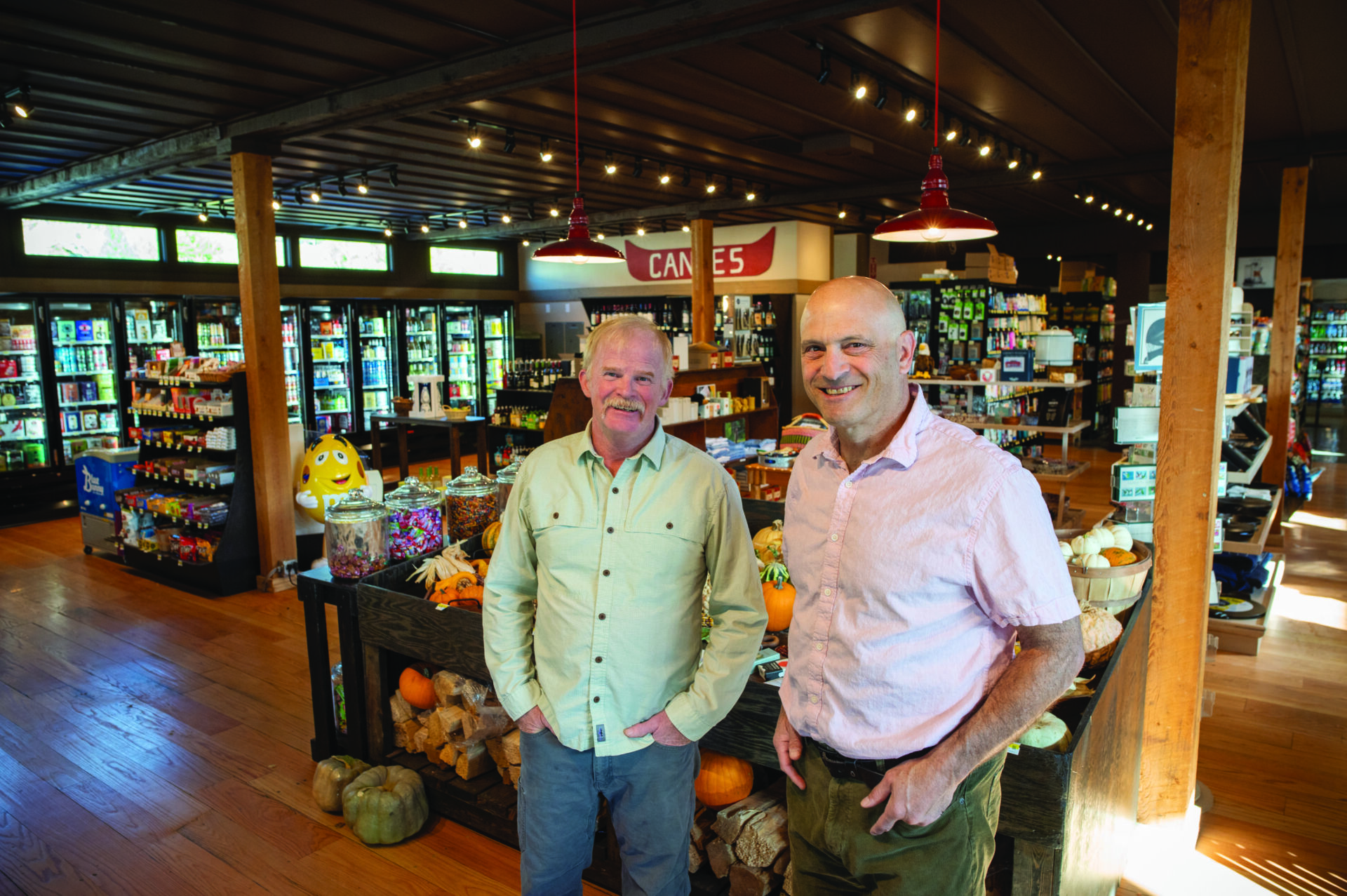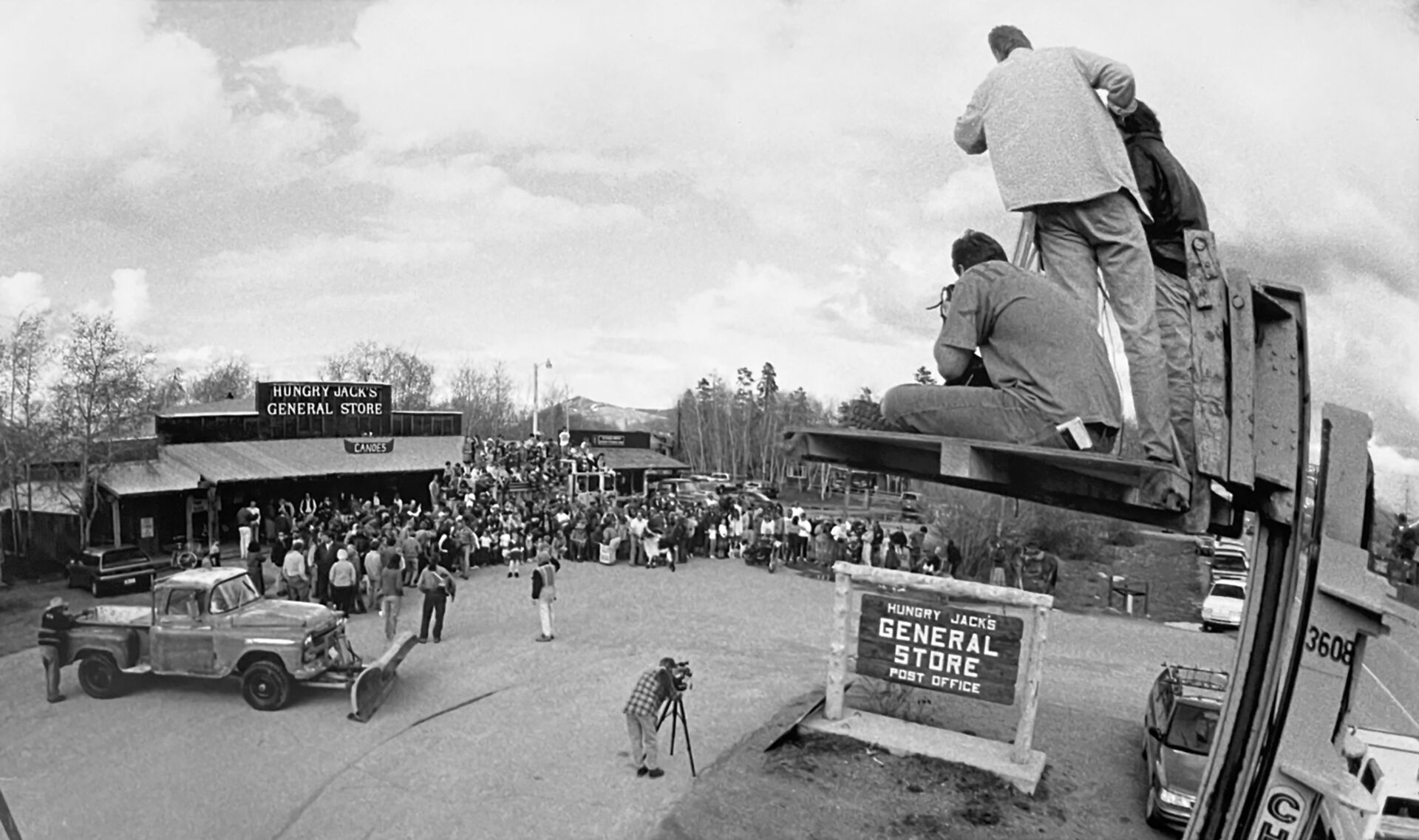Read The
Current Issue
Hungry Jack’s Now & Then
How community unity and local support helped breathe new life in Wilson’s beloved general store.
// By Bevin Wallace

In 1954, Clarence “Stearnie” Stearns and his wife, Dorothy “Dodie,” who had met while working in Yellowstone in the 1940s, bought a small grocery store in Wilson. At that time, Wilson was a blink-and-you’ll-miss-it town at the base of Teton Pass. In 1960, the couple bought the property across the road, hired a builder from Idaho Falls, and six weeks later, opened Hungry Jack’s general store. “It was just like you’d imagine,” says longtime Wilson resident Biz Doyle. “They sold everything from Carhartts to canoes to gallons of milk to greeting cards to steak from the Snake River Ranch.” In 1989 Dodie and Stearnie were ready to retire, so they sold the store to the youngest of their four children, Jana.
Over the years, Hungry Jack’s became a community gathering place. “It had a lot of traditions with it, and the Stearns family were kind of the unofficial mayors of Wilson,” says Doyle. “Stearnie used to sit at this big desk in the center of the store, and it just kind of was his perch where he could command the whole community. It was known without even being said that on the first and last day of school, everyone went to Hungry Jack’s for ice cream. All the kids of Wilson School would flood in there, and Jana would have the ice cream cooler open.”
“It was not a fundraising campaign per se. It was good old-fashioned grassroots spread the word, call your neighbor, and think about what this town would look like without Hungry Jack’s.”
—Biz Doyle

All this—along with the ability of Wilsonites to buy milk without having to drive into Jackson—was in danger of being lost last year when Jana started thinking about retirement. Doyle heard the store was going to be sold and immediately called her neighbor and friend Marc Hirschfield: “I said, ‘This is so sad; we’re gonna lose Hungry Jack’s.’ And he said, ‘Well, we gotta buy it.’ And I said, ‘Well, I don’t have 7.5 million dollars.’” Wilson is “an independent little town with its own post office,” according to Doyle, yet it’s also home to some of the priciest mountain town real estate in the country, according to The Wall Street Journal. The sale of Hungry Jack’s could have easily gone to an out-of-town condo developer or a large retail chain with extra-deep pockets.
Hirschfield’s first reaction was that it needed to be a co-op, but he soon realized that a co-op, which is often a nonprofit, was not the right model for such a valuable business. Hirschfield’s wife, Anise Morrow, did some research, and they landed on the idea of a community-owned business. A COB is an organization owned and operated by a group of people who come together with a common goal, which, unlike traditional corporations, is usually not solely profit, but rather to serve the interests of the local community. The modern equivalent of an old-fashioned barn raising, community-owned businesses solicit neighbors to open their wallets instead of lifting timbers. Members buy in, and they have ownership of both the real estate and the business. “What we found out about community-owned businesses is they kind of really started up in the 1970s and then they went a little defunct. But they were revived during the pandemic when certain communities were losing these very valuable businesses because they couldn’t afford to stay open,” Doyle says.
“We had a couple of community meetings at the old Wilson schoolhouse, and people were very enthusiastic for the project,” says Hirschfield. “We didn’t do any calls,” adds Doyle. “It was not a fundraising campaign per se. It was good old-fashioned grassroots spread the word, call your neighbor, and think about what this town would look like without Hungry Jack’s. At our first meeting, there were over 200 people. They came in, and we were like, ‘Oh boy, we’re gonna need some more chairs.’”
Enthusiasm is one thing, but actually taking people’s money is another. “It was very touch and go, and there was a moment there when we easily could have lost it if we hadn’t raised the money,” says Hirschfield, a former restauranteur who has lived in Wilson since 1994 and who, with his wife, personally put down the non-refundable earnest money for Hungry Jack’s. He credits Morrow for her optimism and faith in the project. “She said, ‘Just get it under contract and we’ll figure it out.’”
“We’re keeping the vibe of a country store where you can kind of get anything, but you can also do your full shop. And the prices are reasonable.”
—Marc Hirschfield

In the end, realizing that independent stores are invaluable to the long-term health and character of the local community, the town of Wilson came together and “saved” Hungry Jack’s. “With a lot of faith and belief, we got it under contract,” Hirschfield says. Hirschfield, Morrow, Doyle, and several others formed the Hungry Jack’s Company with the goal of preserving the store’s legacy while serving the local community with an emphasis on providing staples and goods at reasonable prices. The company’s mission statement says, “While Hungry Jack’s Company seeks to make a profit, it puts community interests first and financial returns second.” Over 600 individuals purchased the 320 shares that were offered at $25,000 each. “Some people bought 10, most people bought one. A lot of people pulled together,” says Doyle.
After the deal was signed on January 18, 2023, Jana Stearns stayed on as manager through the end of the ski season, when the store closed its doors for remodeling. “We had an amazing contractor, Dembergh, with an incredible team as well as subcontractors who have all been great and accommodating,” Hirschfield says. (The contractor and the plumber are also members of the Hungry Jack’s Company.) “We felt it was very important to update it but also maintain the character and not make it feel too fancy.” Morrow and designer Jessica Travis refurbished the store’s original red oak flooring as well as a concrete floor they found below a layer of old vinyl. “We took all the old shelves that Stearnie had built back in the day and sanded them and refinished them. We did some electrical and plumbing work, but we didn’t do that much,” Hirschfield says. They kept the iconic red metal roof, as well as the hand-painted “Welcome Pardner” sign above the front door. “It was very important to us to maintain the history of the store—because everyone feels an attachment to the store,” Hirschfield says.
The new Hungry Jack’s opened on September 2, 2023. “In terms of getting a complicated deal done, getting the building done, in a climate where it can be really challenging, it all went relatively smoothly,” Hirschfield says. “And it’s been extraordinarily well received. With no fanfare, we just turned the sign to ‘open’ and people started streaming in.”
Hungry Jack’s is now more of a local grocer than an old-timey general store. “Back in the day, you could buy waders and tomatoes and fishing gear, but over time it’s become more of a general store-slash-grocery store serving the community. Jackson has become very busy, and it’s nice to have a place in Wilson,” Hirschfield says.
“We have a great product mix. We have inexpensive things like Spam and American cheese and Jimmy Dean sausage, but we also have great olive oil from Sicily. We have Liberty Puzzles, and we also have ponchos for camping,” Hirschfield says. “We’re keeping the vibe of a country store where you can kind of get anything, but you can also do your full shop. And the prices are reasonable.”
Gone are the Carhartt clothing and Sorel boots. (“It was great that you could go to Hungry Jack’s and buy Sorel boots,” says Doyle, “But I’ve lived here 30 years and I have bought one pair of Sorel boots. You just don’t wear them out. It didn’t make sense for us to continue to stock all the sizes.”) But you can still find greeting cards from local artists, coffee table books, enamel cookware, and first aid supplies. The newly opened-up space feels very different from the old store’s mazelike jumble of shelves and implements hanging from the ceiling, and it allows shoppers to more easily find products among the expanded selection of fresh produce, meats, dairy, and specialty foods, including many locally sourced products. Some of the brands, farms, and businesses Hungry Jack’s supports include Huidekoper Ranch farm and Canewater Farm organic produce, Lockhart Ranch beef, Double Diamond Ranch lamb, Morning Dew gourmet mushrooms, Wild Flour bakery, Cattle Kate scarves, Jackson Hole Book Trader, Vertical Harvest, Wonderful Wyoming Honey, Squire Farms local gifts and cheeses, Roots potato chips, Mary’s Chickens free-range poultry, Alaska Gold line-caught seafood, Rainbow Sandals, Haflinger USA slippers, Lodge Cast Iron cookware, Becky Watson artisanal wood creations, MiiR water bottles, CiCi’s handmade Italian cookies, and Tutto Calabria Italian imports. The new company has kept on the previous store manager, Steve Fralin, who, in addition to running the store day-to-day, has been able to provide continuity as well as guidance on vendors and what have historically been popular products. And yes, there is still an ice cream case.
Now that the store is up and running, the next phase is a planned commercial kitchen, which will put out a selection of soups, grab-and-go sandwiches, salads, and baked goods. “Hungry Jack’s has been here for almost 70 years, and we’re trying to create a template for the next 70 years,” says Hirschfield. “We wanted to give the store the new electric, the plumbing, the good refrigeration, a great little commercial kitchen, great space, and great light to become whatever it can become. We’ll always be some sort of grocery store and general store, but there’ll be new people with new talents who are on the board and working here, and we want the store to have the ability to grow and change over time, because it’s community-owned.”
According to Jana Stearns, her parents had a deep love for their community. “They wanted to keep Wilson Wilson!” she said in her speech at the Hungry Jack’s community meeting. That spirit of community and sense of place lives on in the store’s spruced-up new iteration, which is a tribute to the people who came together to preserve this local fixture. “In Jackson Hole, there are so many talented people,” says Hirschfield. “If you let those people contribute, it can create something beautiful.” JH





